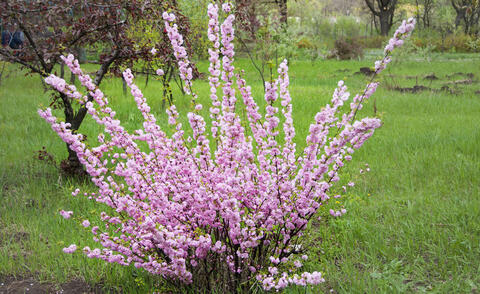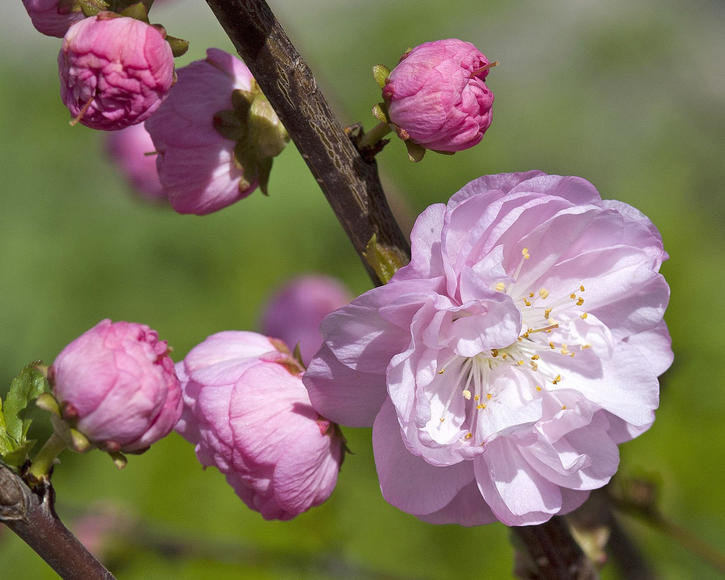Almond trees
As soon as the garden livens up in spring, the abundance of pink double flowers of the Almond tree makes the hearts of many garden owners beat faster. Find out how to properly plant and care for it here.
Factsheet
- Growth type
-
- Deciduous wood
- small tree
- Small shrub
- Growth height (from)
- from 150 cm to 200 cm
- Growth width (from)
- from 150 cm to 200 cm
- Growth characteristics
-
- spherical
- upright
- bushy
- Flower color
-
- pink
- Flowering time (month)
-
- March to April
- Flower shape
-
- Uniflorous
- Shell Flowers
- Flower characteristics
-
- tightly filled
- hermaphroditic
- Leaf color
-
- green
- page format
-
- broad elliptical
- Sheet properties
-
- Autumn coloring
- Drift coloration
- Light
-
- sunny
- Soil type
-
- sandy to loamy
- Soil Moisture
-
- fresh to moderately humid
- ph value
-
- alkaline to weakly acidic
- Lime compatibility
-
- lime-loving
- Nutrient requirements
-
- nutrient-rich
- Humus
-
- rich in humus
- Decorative or utility value
-
- Flower Decoration
- Toxicity
-
- non-toxic
- Winter Hardness
-
- hardy
- Climate zones according to USDA
-
- 5
- Use
-
- Flowerbeds
- Single position
- Group planting
- high-stem
- Planters
- Garden style
-
- Flower garden
- Roof Garden
- Mediterranean garden
- Stone Garden
- Pot garden
The deciduous Almond tree (Prunus triloba) from the rose family (Rosaceae) is native to China.
The Almond tree grows as a small, deciduous, bushy ornamental shrub. It can reach a height and width between 4.9 and 6.56 feet. The Almond tree is also very popular as a tall-stemmed tree.
The dark green leaves are alternately arranged on the branches. They are broadly elliptical in shape and have a serrated edge. The leaf color changes to anywhere between yellow to orange in autumn.
The pink and rosette-shaped double flowers resemble rose blossoms. They are 1.18 to 1.96 inches tall and bloom profusely on the annual branches from March.

Rarely does an Almond tree grow small stone fruits. Birds like to eat them.
Give the warmth-loving Almond tree a sunny and sheltered spot in the garden.
The Almond tree tolerates any normal garden soil, but prefers fresh to moderately moist, sandy-loamy soil. In the long run, it does not tolerate drought and waterlogging.
In general, Almond trees are planted very early in the spring before they sprout. Nurseries offer Almond trees as bushes or a standard tree, mostly as container plants. The best time to plant is early spring. An Almond tree grows well when the planting hole is about twice the size of the root ball. It is good for the almond tree if you mix a third of the compost with the excavated soil. After the planting, the planting hole should be completely filled with the excavated material. Sludging in and a light treading of the earth helps with growth.
Feed your Almond tree with an organic fertilizer in spring. In the container you should water it regularly, because it does not tolerate longer dry periods. When late frost threatens in spring, it is sufficient to cover the flowers with a permeable fleece.

For an Almond tree to grow vigorously, robust pruning is required. Shorten the shoots to 3.93 to 3.14 inches immediately after flowering each year. Thin branches are completely removed. Positive side effect: This also prevents brown rot. Old crowns are rejuvenated by a heavy pruning.
Frosts cannot harm a planted Almond tree. As a potted plant, wrap the shoots with a permeable fleece during the cold season and cover the root area with a coconut mat or fir branches. Alternatively, you can place the container in a frost-free and bright place in the winter months.

To admire the romantic early bloom extensively, it is best to plant an Almond tree within the eyeshot of the house. As a small stand-alone tree, it enhances every front yard. It also enhances a flower bed if planted along with onion flowers and perennials. The tree grows well even in a 40 liter container on the terrace - if it is watered regularly. In addition, the cut branches of the almond tree look excellent in vases. A popular custom is to cut them at the beginning of December as barbara branches.
Only grafted Almond trees are sold in the nurseries. It is therefore not worthwhile to propagate the wood yourself using cuttings.
Almond trees are prone to Monilia infection also known as brown rot. The tips of the shoots die off as a result of the infection. The disease usually occurs immediately after flowering. Annual pruning can prevent this fungal infection.

